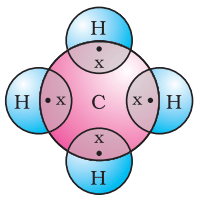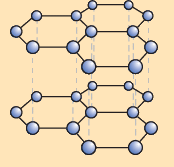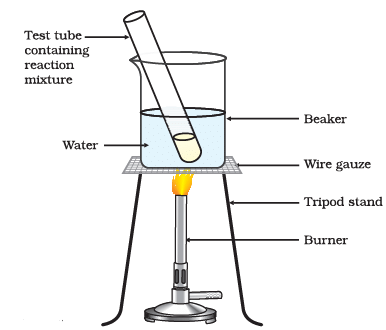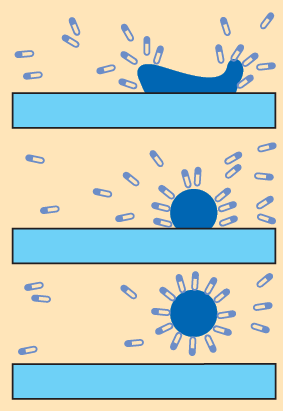Diagram Based Questions: Carbon and its compounds | Science Class 10 PDF Download
Q1: Answer the following questions based on the diagram given below: Covalent Bond of Methane
Covalent Bond of Methane
(ii) What is the chemical formula of methane?
Ans: The chemical formula of methane is CH4.
(ii) How many valence electrons does carbon have in methane?
Ans: Carbon has four valence electrons in methane.
(iii) How many hydrogen atoms are bonded with carbon in methane?
Ans: In methane, carbon is bonded to four hydrogen atoms.
(iv) What type of bonds are formed between carbon and hydrogen in methane?
Ans: Covalent bonds are formed between carbon and hydrogen in methane.
(v) Why are covalent compounds like methane generally poor conductors of electricity?
Ans: Covalent compounds like methane are poor conductors of electricity because they have shared electrons between atoms, and no charged particles (ions) are formed within them, limiting their ability to conduct electrical current.
Q2: Answer the following questions based on the diagram given below:
 Allotropic Form of Graphite
Allotropic Form of Graphite
(i) What is the basic structure of graphite?
Ans: Graphite is made up of hexagonal arrays of carbon atoms in layers. Each carbon atom is bonded to three other carbon atoms within the same plane, and one of these bonds is a double bond.
(ii) How are the layers of carbon atoms arranged in graphite?
Ans: The layers of carbon atoms in graphite are placed one above the other, creating a stacked structure.
(iii) Why do diamond and graphite have different physical properties despite having the same chemical properties?
Ans: Diamond and graphite have different physical properties because of their distinct structures. Diamond's three-dimensional, tightly packed structure makes it the hardest substance, while graphite's layered structure allows it to be smooth, slippery, and a good conductor of electricity.
(iv) What is the significance of the double bonds between carbon atoms in graphite?
Ans: The double bonds between carbon atoms in graphite satisfy the valency of carbon and provide stability to the structure.
(v) How does the arrangement of carbon atoms in graphite contribute to its excellent electrical conductivity?
Ans: The hexagonal arrangement of carbon atoms in graphite allows for the presence of free electrons between the layers. These free electrons can move easily, making graphite an excellent conductor of electricity.
Q3: Answer the following questions based on the diagram given below:
 Formation of Ester
Formation of Ester
(i) What is the process shown in the diagram titled "Formation of Ester"?
Ans: The process shown in the diagram is the formation of an ester, which is a chemical reaction between an alcohol and a carboxylic acid to produce an ester and water.
(ii) What are the two main reactants involved in the formation of an ester?
Ans: The two main reactants involved in the formation of an ester are an alcohol and a carboxylic acid.
(iii) What type of bond is formed during the formation of an ester, and what is the byproduct of this reaction?
Ans: A covalent bond called an ester bond is formed during the reaction, and the byproduct is water (H2O).
(iv) What are some examples of esters that are commonly found in nature or used in everyday life?
Ans: Examples of esters found in nature include the esters responsible for the scent of flowers and fruits. Esters are also used in artificial flavorings and fragrances, such as isoamyl acetate (banana flavor) and ethyl acetate (nail polish remover).
(v) How does the formation of esters contribute to the world of perfumes and flavors?
Ans: The formation of esters is essential in the production of perfumes and flavors. By carefully selecting different alcohol and carboxylic acid combinations, chemists can create a wide variety of pleasant scents and flavors that mimic those found in nature, enhancing our experiences with perfumes and food.
Q4: Answer the following questions based on the diagram given below: Formation of micelles
Formation of micelles
(i) What is the main reason behind using soap for cleaning?
Ans: The main reason for using soap for cleaning is that soap molecules can form structures called micelles, which help in removing dirt and oil from surfaces, making it easier to wash them away with water.
(ii) How do soap molecules interact with both water and oil?
Ans: Soap molecules have one end that is attracted to water (hydrophilic) and another end that is attracted to oil (hydrophobic). This allows soap to interact with both water and oil simultaneously.
(iii) What is a micelle, and how does it form?
Ans: A micelle is a structure formed by soap molecules in water. In a micelle, the hydrophilic (water-attracting) ends of soap molecules face outward, while the hydrophobic (oil-attracting) ends cluster together inside, surrounding and trapping oil and dirt particles.
(iv) Why doesn't oil dissolve in water, and how do micelles help in cleaning oily substances?
Ans: Oil doesn't dissolve in water because oil is hydrophobic and repels water. Micelles help in cleaning oily substances by encapsulating the oil droplets within their hydrophobic cores, allowing them to be carried away in water, effectively removing the oil.
(v) How does soap make it easier to wash clothes clean?
Ans: Soap makes it easier to wash clothes clean by forming micelles that surround and lift away oily and dirty particles from the fabric. These micelles keep the dirt suspended in water, allowing it to be rinsed away when we wash our clothes, resulting in cleaner and fresher laundry.
Q5: Answer the following questions based on the diagram given below:


(i) What happens to soap molecules when they are at the surface of water?
Ans: When soap molecules are at the surface of water, their hydrophobic tails protrude out of the water, while the ionic ends interact with the water, causing the soap molecules to align along the water's surface.
(ii) How do soap molecules organize themselves when they are in water?
Ans: Inside water, soap molecules form structures called micelles. In a micelle, the hydrophobic tails are on the interior of the cluster, while the ionic ends are on the surface of the cluster.
(iii) Why is soap able to clean effectively?
Ans: Soap can clean effectively because it forms micelles, which trap oily dirt in their center. The hydrophobic tails of soap surround and isolate the dirt, making it easy to rinse away with water.
(iv) Why do soap micelles stay in solution as a colloid?
Ans: Soap micelles remain in solution as a colloid due to ion-ion repulsion. The ionic ends of soap molecules on the surface of micelles repel each other, preventing the micelles from coming together to precipitate.
(v) Why does a soap solution appear cloudy?
Ans: A soap solution appears cloudy because soap micelles are large enough to scatter light. The scattering of light by these micelles gives the solution its cloudy appearance.
|
80 videos|569 docs|80 tests
|
FAQs on Diagram Based Questions: Carbon and its compounds - Science Class 10
| 1. What is the structure of carbon dioxide? |  |
| 2. How is carbon dioxide produced in the atmosphere? |  |
| 3. What are hydrocarbons? |  |
| 4. What is the difference between saturated and unsaturated hydrocarbons? |  |
| 5. How does carbon form multiple compounds? |  |





















